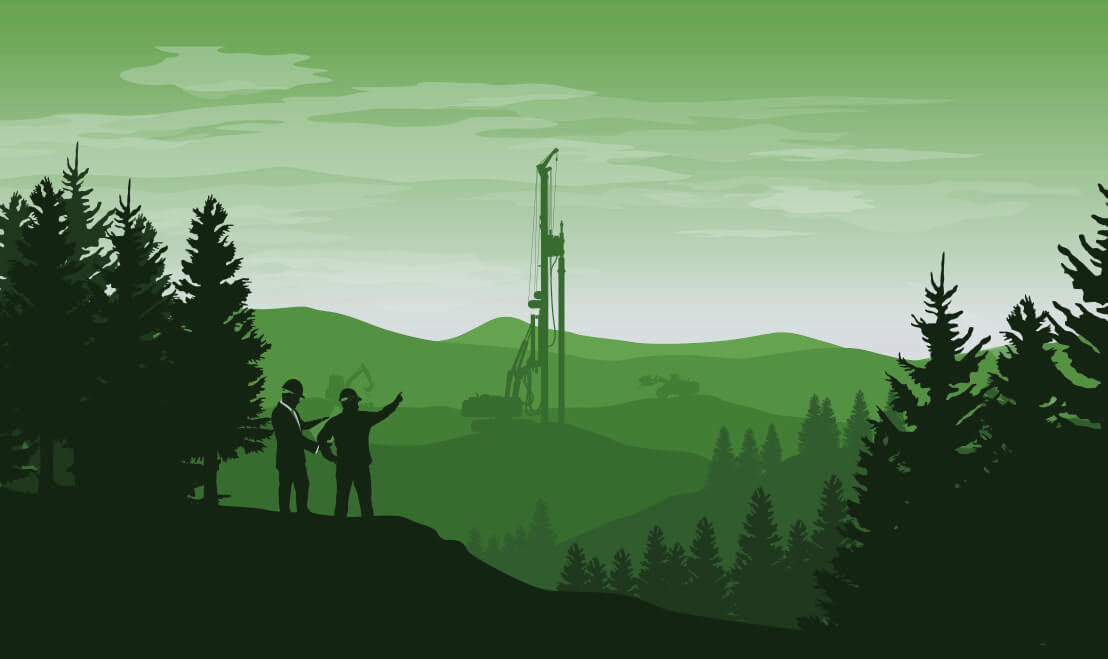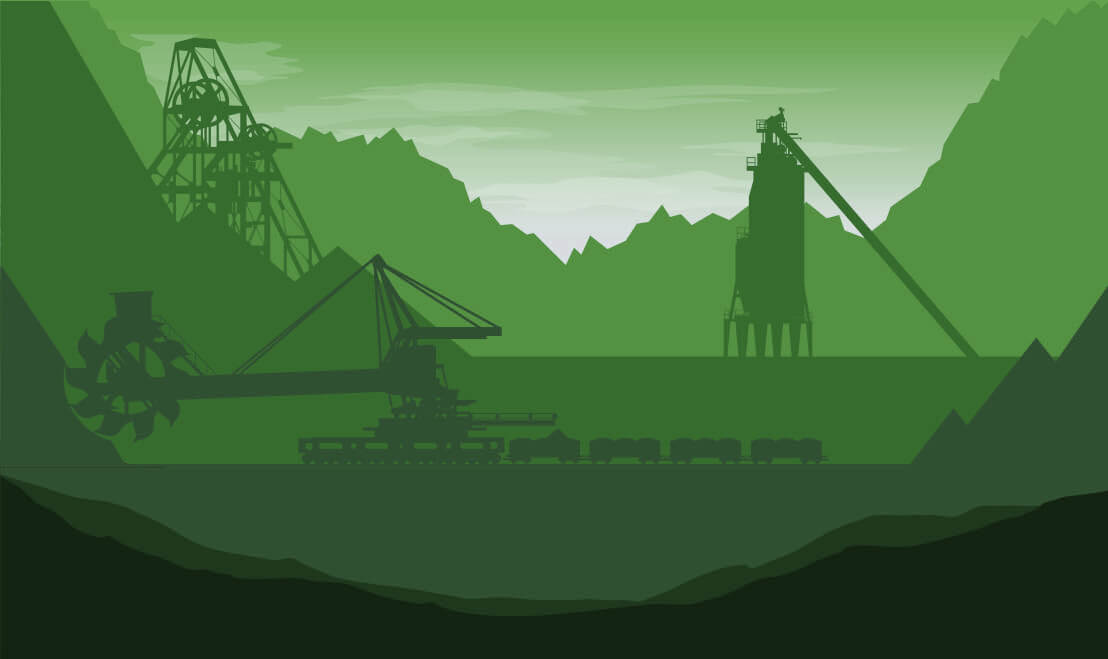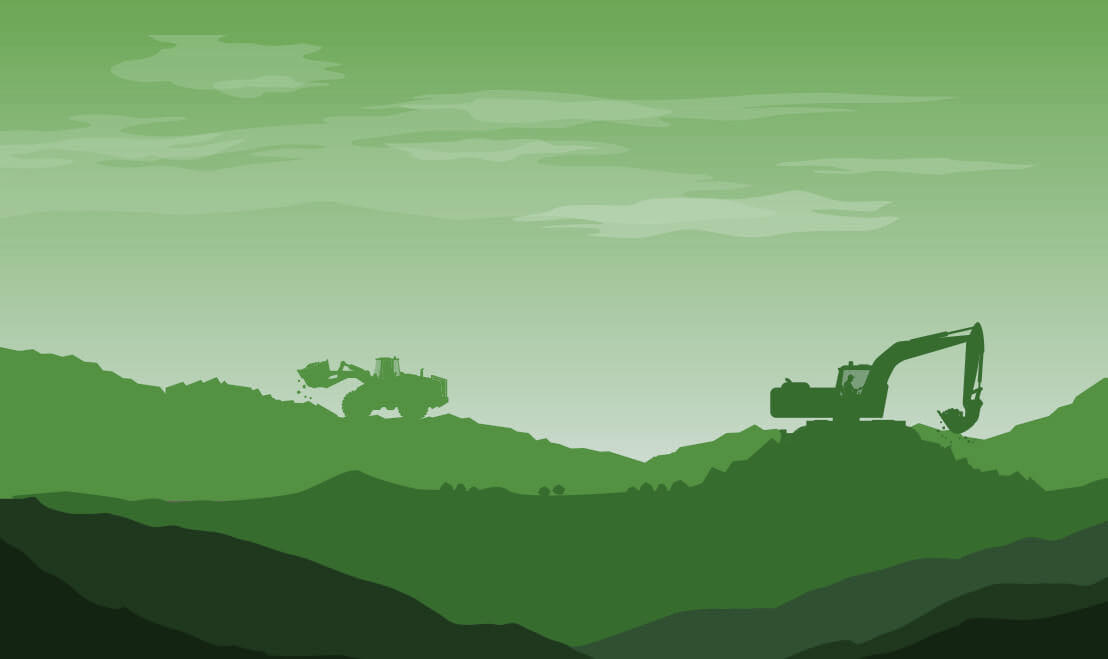The Life Cycle of a Mine
There are several stages in the mining lifecycle including exploration, design, construction, operation, and reclamation. Each step in the mining lifecycle requires science, engineering, technology, community involvement and careful planning, and is governed by stringent state and federal environmental protection regulations, as well as financial assurance obligations.
Before Mining: Planning, Design, & Development

Discovery and Exploration
Mineral deposits are a natural occurrence of a useful mineral formed within the earth’s crust; however, a deposit of sufficient size that is viable to extract is rare. Exploration starts with identifying areas that might have favorable geology for a mineral deposit to occur.
Exploration can be challenging in places like Wisconsin where the bedrock is generally not exposed at the surface but rather is often covered with up to hundreds of feet of glacial deposits.
Activities associated with discovery and exploration include negotiating mutually beneficial agreements with landowners, acquiring the required permits, and developing a drilling and analysis plan to evaluate the grade and extent of potential ore.
A mining company must submit any required permit applications to local and state agencies that show compliance with local and state requirements, which may include demonstrating how the environment would be protected by containing all drilling materials, preventing air pollution, limiting noise, and protecting wetlands and wildlife.
Once drilling is completed, all refuse and drilling supplies and equipment must be removed from the site, and the location will be reclaimed.
Design and Development
If a favorable deposit is found, a project may advance to the development and design stage. This involves rigorous engineering and planning studies to evaluate the environment and natural resources of the area and to determine if the deposit can be profitably mined.
Mining engineers will look at many factors including the depth to the orebody, the geometry and the orientation of the deposit, and the grade of the mineralization to determine whether the deposit is mined as an underground mine or a surface, sometime referred to as an “open-pit” mine.
A feasibility report is generated, taking into account estimated production rate, operating costs, taxes, and the sale price of the mineral, as well as environmental and social factors, so that the mining company can then decide whether the project will be abandoned or the necessary approvals will be requested at this stage. If the project moves forward, the mine plan developed from the feasibility study is used to initiate the permitting process.
The environmental permitting process for a proposed mine begins after the feasibility study during project development. Environmental baseline studies are expanded in the feasibility study phase to support the evaluation of mining alternatives. In the permitting phase, the environmental baseline studies continue to support the permitting process.
Companies seeking to develop a mine in Wisconsin must work closely with the Wisconsin Department of Natural Resources (DNR) to collect extensive data to document pre-mining conditions. Reports regarding potential impacts on the environment and nearby communities are generated. These reports cover physical conditions including geology, soil, and seismic activity; biological conditions such as surface water, groundwater, wetlands, air quality, vegetation, and wildlife; and social/economic conditions related to health, well-being, housing, infrastructure, and archeological and cultural issues.
Wisconsin has comprehensive regulations governing mineral exploration, development, mining, and reclamation that are based on an environmental review process.
Mining applicants must prove that their proposed operation can be built, operated, and closed in compliance with numerous environmental protection standards that safeguard all aspects of the environment in and around a proposed mine site. As part of this review process, an environmental impact assessment must be completed by the the DNR and federal agencies that evaluates the potential environmental, social, and health impacts of the proposed project. Measures, management plans, and design changes to minimize or manage potential impacts are specified in the impact assessment. These are reviewed by state and federal agencies, as well as the public.
The mining company begins planning for mine closure and reclamation early on; even before a mine is allowed to open, a reclamation plan must be approved for its closure. In these reclamation plans the mining operator describes the processes it will use to restore or redevelop the land that has been mined to a more natural or economically usable state.
They must also provide financial assurance to state and federal agencies to give regulators the necessary funds to reclaim the mine if the operator should be unable to do so.
During Mining: Operations & Production

Operations and Production
Metallic mining operations can take several forms, depending on the ore body and quality. In general, mines are either surface mines or underground operations. Surface mines are most commonly used.
In general, there are several core areas or facilities of operation: mineralized area and mine pit, milling, waste rock disposal areas, tailings disposal facility, water treatment and management facility, and control or operations facility.
Mine Pit
In surface mine operations, the first step is the removal of overburden and waste rock to expose mineralized rock – this step creates the largest volume of waste in the mining process. The mine shape depends upon the mineral deposit and is typically a series of benches, terraces, and ramps that enable the machinery to reach the base of the mine. Waste rock and ore are excavated by drilling 6-12 inch “blast holes” in a specific pattern, which are filled with explosives. They are then detonated in a controlled manner. Once removed, the ore is transported for processing using large haul trucks.
Milling
Regardless of the deposit type and mining process, ore must be separated from the waste rock once it has been removed from the ground. The minerals are removed from the ore by using one or more methods, and this separation is usually done in a mill.
The most common type of milling or recovery is called floatation. The ore is crushed into a very fine powder, and the powder is put into an agitated slurry. Minerals may sink to the bottom or stick to the bubbles and rise to the top, where they are skimmed off. This process is used to separate the valuable metals from other minerals, after which the recovered metals are sent on for further processing. The waste material is either used as backfill in the mine or sent to a tailings pond, where the water is removed. All waste material is carefully handled and managed as required in the mining permit.
After Mining: Reclamation and Continued Land Use


Reclamation and Closure
Wisconsin’s mining regulations include detailed mine closure and reclamation requirements to ensure environmental protection after mining is completed and to guarantee the land can be used after mining for other beneficial purposes.
Considerations when planning for closure include: protecting public health and safety, addressing environmental protection, returning the land to its original state or an acceptable new use, and sustaining social and economic benefits brought by the mine.
The process of reclamation includes maintaining water and air quality and minimizing flooding, erosion, and preventing harm to wildlife and wildlife habitat. The final step in the reclamation process is often topsoil replacement and revegetation with suitable plant species.
Financial Assurance and Bonding
Federal and state regulations require mining companies to provide funding for closure before the mining project begins. This is to ensure that reclamation is completed at the end of mining activities. Mining companies remain responsible for the mine site indefinitely. They must continue to collect environmental monitoring samples from area streams and wells to ensure that the mine is complying with all water quality requirements for surface water and groundwater. Companies are required to maintain proof of financial responsibility for a closed mine site for at least 40 years and set aside funding to maintain the mine’s water management systems for 250 years.